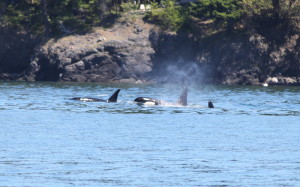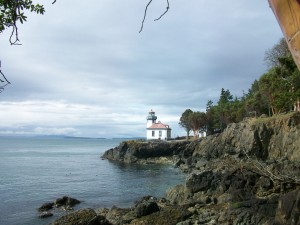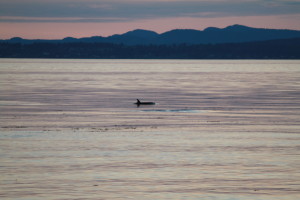The Second Summer
Summer brings many things to the San Juan Islands… Sunshine and warm weather grant us long days, gardens and fields full of greens and flowers, and an ocean brimming with life. The Salish Sea undergoes a boom of productivity in the summertime. As the phytoplankton bloom, the forage fish prosper and salmon begin to pump through the winding channels and straits, making their way back to natal streams to spawn. And who loves salmon more than we do? The Southern Resident Killer Whales, and so as they return to the Salish Sea, I follow suit, returning to the lighthouse and Lime Kiln State Park for the second summer.
Lime Kiln Lighthouse, for those who aren’t familiar, is on the west side of San Juan Island in Washington State. The Southern Resident killer whales (SRKW), an endangered population of orcas, often pass the lighthouse in the summer time as they chase after their prized prey, Chinook salmon. Being able to watch the whales from shore makes the lighthouse an icon of the island, and an ideal location to conduct research. This summer I am lucky enough to return to the lighthouse and my research project from last summer to work with the Beam Reach Program and The Whale Museum again as a University of Washington Mary Gates Research Scholar. Both Beam Reach and the Whale Museum support the Salish Sea Hydrophone Network, which has a hydrophone array in the water that I am using to record SRKW vocalizations and monitor underwater sound here at the lighthouse.
Just like last summer, my first full day back at the lighthouse I was lucky enough to have whales pass by. We heard them coming from a mile away, literally, as they passed the Orcasound hydrophone and Center for Whale Research heading south down the west side of the island. Members of L pod passed us by in a fairly quick, yet exciting encounter. The whales were incredibly vocal, producing lots of pulsed calls, squeaks, and echolocaiton clicks. A few individuals even breached, although it was off in the distance. I couldn’t have asked for a better first day back. That evening, as L Pod made their way back out to sea, a few transients crept along the west side. Although they never quite reached the lighthouse, I got a peak at them with my binoculars. The rest of the week was pretty slow here at Lime Kiln. A sub-group of L pod, known as the L-12s, was hanging around on and off last week, but they seem to prefer the southwest side of the island to the lighthouse, although they did make their way north for the Orca Sing celebration Saturday evening.
Since then, the lighthouse has been quiet; the days have been spent gearing up for the summer, talking with visitors, and thinking about the Southern Residents and their relationship with the ecosystem. Whale activity has been relatively slow for the month of June this year and it has me, and others, scratching our heads. What is keeping the whales away from the west side? Is there not enough salmon for them to eat? Are there too many boats? Have they found a better place to hang out for the summer? Whatever the reason, I hope they start shuffling the west side again soon! Help me, and other scientists, monitor killer whale activity by listening to the Salish Sea Hydrophone network, logging your observations, and sending out email alerts when you hear whales.
As I was writing this blog post, we got word of L-Pod in the Strait of Juan de Fuca. I am hoping they continue swimming east until they arrive back here at Lime Kiln. Maybe J-Pod and K-Pod are following them in? Until then, I will keep listening to the hydrophones and thinking about what they might be up to out in the ocean.
Read More





 Twitter
Twitter LinkedIn
LinkedIn Facebook
Facebook